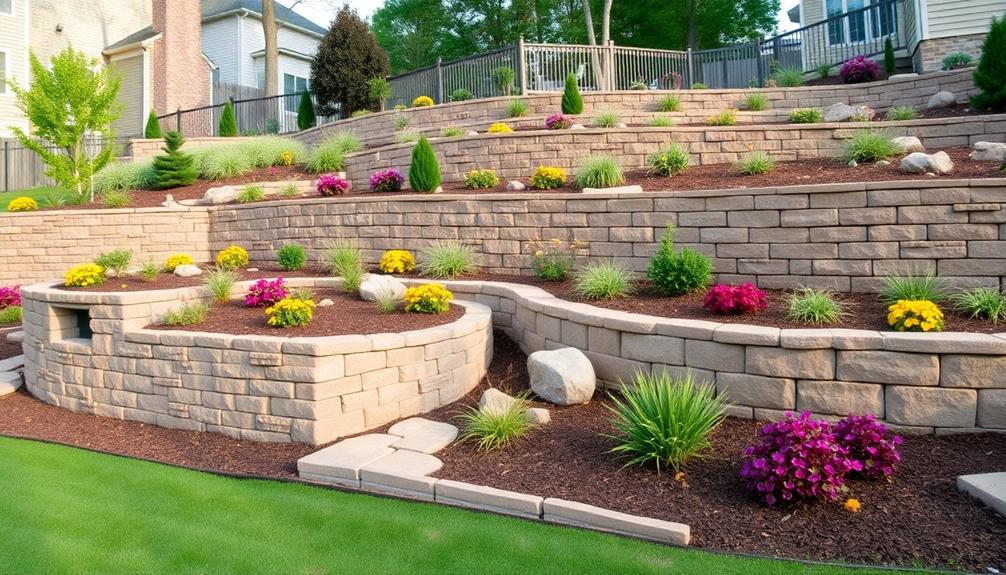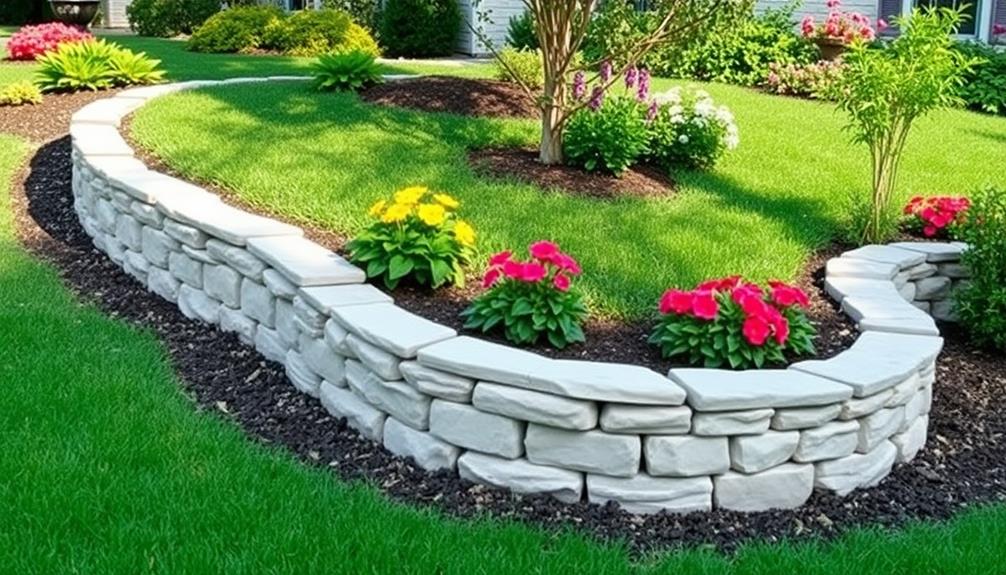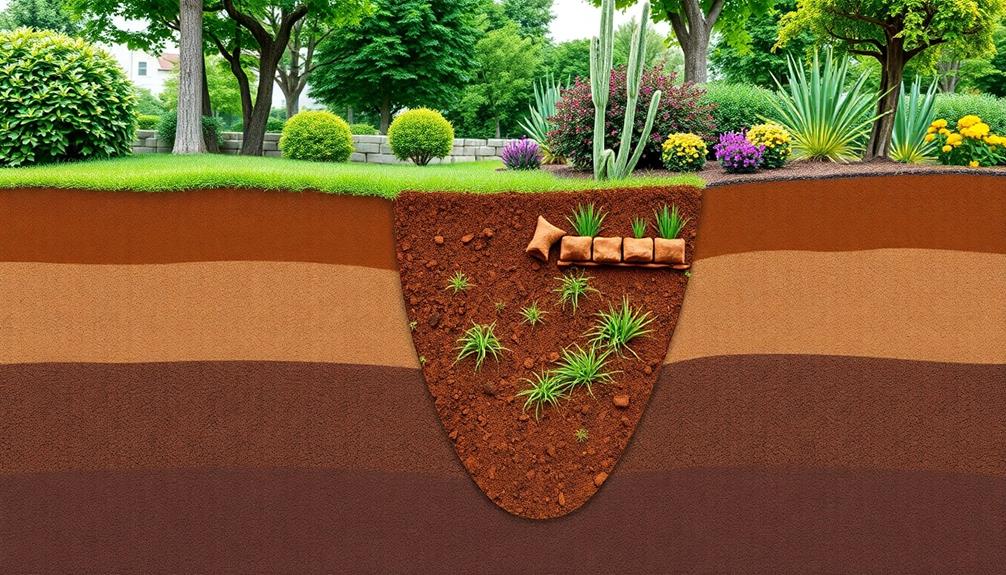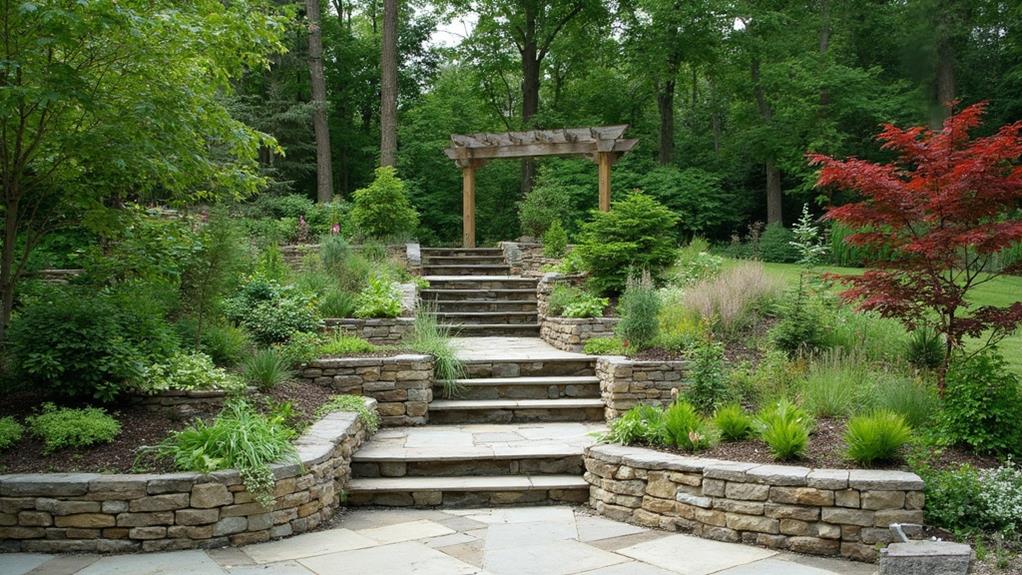Selecting the ideal retaining wall design requires careful analysis of numerous factors. Start by evaluating the site conditions, including soil type, slope gradient, and drainage needs, as these influence the wall’s stability and performance. Choose materials such as concrete, stone, brick, timber, or modular blocks based on their design flexibility, durability, and aesthetic appeal. Consider how the wall will integrate with the surrounding architecture and landscape, ensuring a harmonious balance between functionality and visual charm. Prioritize structural integrity by adhering to load-bearing capacities, appropriate reinforcements, and compliance with local building codes. Understanding these elements sets a foundation for successful design.
Table of Contents
ToggleWalls Contractor Highlights
- Assess site conditions including soil stability, terrain gradient, and hydrostatic pressure to select an appropriate design.
- Choose materials like concrete, stone, or modular blocks, balancing strength, aesthetic appeal, and environmental considerations.
- Ensure structural integrity through proper load-bearing and reinforcement, complying with local building codes.
- Incorporate sustainability by using eco-friendly materials and advanced erosion control techniques for long-term durability.
- Align retaining wall design with architectural style and landscape to optimize property value and curb appeal.
Understanding Retaining Walls

Retaining walls serve a critical function in landscape and structural engineering by providing lateral support to vertical slopes of soil, preventing erosion and land movement. These structures not only thwart soil erosion but also create usable areas for gardening, patios, and parking, effectively transforming unusable space into something amazing.
The choice of materials, including concrete, stone, and timber, profoundly impacts the wall’s durability and aesthetic appeal, demanding careful selection based on project-specific environmental and load-bearing requirements. Essential design considerations encompass understanding soil characteristics, drainage needs, and load factors, all of which guarantee the stability and longevity of the structure while meeting regulatory and safety standards.
Purpose of Retaining Walls
In the domain of civil engineering and landscape architecture, retaining walls perform an indispensable function by preventing soil erosion and managing slopes. Recognized for their ability to maintain the structural integrity of terrains, these walls can transform challenging landscapes into functional and aesthetically pleasing environments. Retaining walls are essential in preventing the displacement of soil, safeguarding buildings and infrastructure from the damaging effects of erosion. By stabilizing uneven surfaces, they contribute to enhanced land usability and safety, reducing the risk of landslides in vulnerable areas.
Moreover, retaining walls support the creation of level spaces on sloped land, facilitating the optimization of outdoor living spaces, creating terraces, and contributing to the seamless integration of natural and built environments. Their role extends beyond mere functionality; they form a pivotal part of the holistic environmental planning process, promoting sustainable land development.
Retaining walls can also channel water efficiently, aiding in stormwater management to mitigate flooding and soil erosion during heavy rainfall. By doing so, they guarantee that landscapes remain not only stable but also harmonious, offering a sense of security and belonging to those who inhabit and traverse these spaces.
Types of Materials
What materials are commonly used in the construction of retaining walls, and how do they influence functionality and aesthetics? Among the various materials available, concrete, stone, brick, timber, and modular blocks are prevalent choices. Each material offers distinct advantages with regard to durability, appearance, and compatibility with the surrounding environment, ultimately shaping the wall’s functionality and aesthetic appeal.
Concrete, renowned for its strength and flexibility, can be molded into diverse shapes and sizes, providing robust support for heavy loads while allowing for creative design possibilities. Stone, with its natural allure, seamlessly integrates into landscapes, offering timeless elegance and considerable durability, though it may command a higher price and more meticulous installation.
Brick reinforces a sense of permanence with its uniform appearance and the ability to complement architectural designs. Timber, often selected for its rustic charm, may require regular maintenance to resist environmental degradation but provides a warm, natural look that resonates with those who value tradition. Modular blocks, engineered for easy installation and variability, offer an accessible solution for a range of structural requirements, allowing for personalization of the wall’s appearance while ensuring structural soundness. Each material choice reflects a balance between personal aesthetic preferences and the wall’s intended purpose, allowing homeowners to achieve cohesion with their surroundings.
Design Considerations
When considering the ideal material for a retaining wall, understanding the key design considerations is paramount to ensuring both functionality and longevity. Beyond choosing the right material, thoughtful attention must be paid to the interplay of structural requirements and aesthetic preferences. A well-designed retaining wall embodies a commitment to lasting stability and harmonious integration into its environment.
Site-specific conditions: Soil type, slope gradient, and hydrostatic pressure greatly influence the retaining wall’s design requirements. Monitoring these elements can prevent potential structural failure.
Load and usage demands: Anticipate the weight and type of loads the wall will support. Walls tasked with sustaining heavy or periodic loads necessitate reinforced construction, often incorporating concrete or galvanized steel.
Environmental impact: Opt for sustainable materials and techniques that complement local ecosystems. Indigenous materials not only resonate with community sensibilities but bolster ecological responsibility.
Engaging with these considerations fosters a collaborative approach among homeowners, architects, and engineers, ensuring the retaining wall not only fits seamlessly within its landscape but also embodies the collective ethos of safety and sustainability. By interweaving meticulous planning with community values, each retaining wall project becomes a symbol of shared purpose and thoughtful design.
Benefits

Retaining walls serve as a strategic solution to enhance erosion control, preserving the integrity of landscapes by preventing soil runoff and ensuring long-term stability. These structures not only direct rainwater away from homes but also create usable areas for gardening, patios, and parking pads.
In addition to their functional prowess, these structures substantially elevate property aesthetics, offering a visually appealing element that can complement architectural designs, while also increasing the usable land available for residential or commercial purposes. By ensuring structural stability, they provide peace of mind to property owners, safeguarding investments against natural forces and maximizing the site’s potential.
Enhanced Erosion Control
Implementing enhanced erosion control measures in retaining wall design offers significant benefits, ensuring the longevity and stability of the structure. Erosion control is an essential aspect of landscape management, particularly for properties located in areas with significant rainfall or near bodies of water. Employing advanced techniques for erosion prevention not only preserves the land but also secures the structural integrity of retaining walls.
The benefits of enhanced erosion control in retaining walls can be outlined as follows:
- Reduced soil displacement: Advanced erosion control measures prevent soil from being washed away, which subsequently decreases the risk of wall displacement or collapse.
- Increased land usability: By maintaining the structural area intact, these practices allow for more effective use of the surrounding land, often enabling landscaping or recreational enhancements.
- Cost-effective maintenance: Preventive erosion control minimizes the need for frequent repairs or replacements, saving property owners substantial maintenance costs over time.
Incorporating these strategies provides property owners a sense of community belonging, knowing they are acting responsibly towards their environment while preserving their investment. By harnessing the power of enhanced erosion control, retaining walls contribute to a more sustainable and harmonious landscape, reflecting foresight and respect for natural processes.
Improved Property Aesthetics
An elegant facade can markedly enhance the visual appeal and value of a property. Retaining walls, often seen as functional necessities, serve as crucial opportunities to refine a property’s aesthetics, harmonizing structural integrity with visual splendor. By seamlessly integrating the design of retaining walls with the natural environment, property owners can create landscapes that resonate with a sense of distinction and belonging, which is quietly yet profoundly appreciated by residents and visitors alike.
Materials such as natural stone, textured concrete, or even sustainable wood options can be used to construct these walls, each material bringing its own unique aesthetic to the forefront. For instance, stone exudes a timeless elegance that seamlessly blends with lush greenery, while concrete can be customized with various textures and colors to complement contemporary architecture. Additionally, the strategic placement of retaining walls can help frame gardens or patios, turning otherwise unused spaces into inviting, picturesque vistas.
Furthermore, decorative elements such as integrated lighting or cascading plants can supplement these structures, providing a functional yet ornamental role. Together, these enhancements elevate the retaining wall beyond a mere boundary, transforming it into an essential component of the property’s overall aesthetic narrative, thereby strengthening a tangible connection to one’s environment.
Increased Usable Land
By thoughtfully designing and constructing retaining walls, property owners can effectively increase usable land, transforming previously unmanageable slopes into functional, level areas. This transformation not only maximizes the potential of the landscape but also enhances the property’s value.
Additionally, creating flat, usable space can considerably broaden the scope for various activities, making the land more adaptable to diverse needs and aspirations.
Consider the multiple advantages of increased usable land:
- Expanded Recreation Areas: Homeowners can establish gardens, patios, or play areas that foster family gatherings and community interactions.
- Enhanced Landscaping Opportunities: Level surfaces enable more structured and aesthetic gardening designs, contributing to the natural beauty of the property.
- Potential for Improved Infrastructure: Flat land can accommodate new structures such as sheds or garages, optimizing the utility of the property.
Through this, property owners can cultivate a sense of community and shared spaces, appealing to those who wish to connect with others in a harmonious environment. Moreover, the augmentation of usable land through retaining walls reflects thoughtful planning, underscoring a commitment to sustainable and efficient land use for current and future residents.
Ultimately, retaining walls serve as pivotal elements, bridging aesthetic intent with practical necessities, thereby crafting environments that speak to the intricate balance between nature and human needs.
Structural Stability Assurance
Ensuring structural stability in retaining wall design is paramount to safeguarding both the landscape and the structures it supports. Retaining walls must withstand various forces, including the pressure exerted by the soil they hold back. Properly engineered retaining walls provide an essential foundation that prevents soil erosion and landslides, contributing to the safety and longevity of nearby infrastructures.
Additionally, a structurally sound retaining wall maintains the intended form and function of the landscape, thereby ensuring that the built environment remains both aesthetically pleasing and functionally efficient over time.
Structural stability assurance benefits extend beyond mere safety; it signifies resilience and durability. Incorporating elements like appropriate drainage systems, carefully selected materials, and precise construction techniques helps in minimizing maintenance needs and prolonging functional life.
For those seeking a sense of belonging in their community, a well-constructed retaining wall reinforces the integrity of shared environments. It reflects a commitment to quality and consideration for collective spaces. Such stability not only enhances property value but also fosters community pride. Retaining walls that stand the test of time exemplify a conscientious investment in practical design and communal harmony.
Soil Type Considerations

When designing a retaining wall, understanding the nature of the soil is essential, as it directly influences the wall’s structural integrity and long-term reliability. Key factors that must be assessed include soil drainage requirements, soil load capacity, and soil erosion risks, each of which determines the design’s adaptability to different soil conditions and climates. The following table provides a concise comparison of these soil considerations:
| Factor | Importance |
|---|---|
| Soil Drainage | Guarantees water does not accumulate and weaken the wall |
| Soil Load Capacity | Determines the maximum weight the soil can bear without failure |
| Soil Erosion Risks | Evaluates the potential for soil displacement that can compromise the wall |
Understanding these elements aids in choosing the appropriate materials and methods for construction, confirming the wall’s durability and effectiveness.
Soil Drainage Requirements
Understanding soil drainage requirements is paramount in retaining wall design, as it directly influences the stability and longevity of the structure. Proper drainage prevents water buildup behind the wall, reducing hydrostatic pressure which can lead to wall failure. Soil drainage systems must be carefully considered to accommodate varying soil conditions and make sure water is efficiently directed away from the structure.
Key considerations when evaluating soil drainage include:
- Permeability of the soil: Different soil types, such as sandy or clay soils, have distinct drainage properties. Sandy soils, for example, provide natural drainage due to their coarse texture, whereas clay soils retain water, necessitating additional drainage solutions.
- Surface water management: Effective management of surface water is indispensable, involving grading of the land to prevent water from pooling behind the wall and utilizing effective runoff systems like French drains or weep holes.
- Climatic conditions: Seasonal changes, such as consistent rainfall or freeze-thaw cycles, can impact drainage requirements by altering the moisture content and deposition rate around the retaining wall.
For individuals seeking connection to their environment, a well-executed drainage plan not only preserves structural integrity but integrates seamlessly with the surrounding landscape, fostering a sense of harmony with natural elements.
Soil Load Capacity
Evaluating soil load capacity is essential in the design phase of a retaining wall, as it determines the wall’s ability to withstand the pressures exerted by the retained earth. This consideration is imperative to ensuring that the structure remains stable over time, supporting not only the weight of the soil itself but also any added burdens from water saturation, nearby buildings, or dynamic loads like vehicles. Understanding the type of soil present is instrumental in calculating load capacity, as different soils possess varying attributes that affect stability.
Clay, for instance, tends to absorb water, leading to expansion and increased pressure on a wall, whereas sandy soils provide better drainage but lower cohesion, potentially impacting stability. Loam soils offer a balanced mix, possessing moderate water retention and adequate firmness, making them ideal for many retaining wall applications. The soil’s classification, whether cohesive or granular, influences how engineers design the wall’s thickness, height, and reinforcement.
Professionals working together towards a shared goal of creating an effective retaining wall need to carefully assess soil conditions and load capacities, ensuring that each design decision aligns with the unique composition of the earth it will support, fostering a sense of shared responsibility and accomplishment.
Soil Erosion Risks
In designing retaining walls, soil erosion risks are a critical factor that must be addressed to confirm long-term structural stability. Soil erosion not only undermines the integrity of the wall but also influences the surrounding landscape, which can exacerbate drainage issues and lead to more substantial repair needs. It is essential for homeowners and builders to understand how different soil types interact with environmental factors, as these will determine the most appropriate erosion control measures.
Certain soil types are more susceptible to erosion, necessitating specific attention to detail. For instance, sandy soils are prone to shift and erode quickly due to their loose particle structure, while clayey soils may expand and contract with moisture changes, leading to instability. Recognizing these variances confirms that the design and materials selected for the retaining wall are contextually suited to mitigate erosion challenges.
Consider:
- Drainage systems: Implement thorough drainage plans to handle water runoff effectively, reducing pressure and erosion risks.
- Geotextile fabrics: Use these fabrics to separate layers of soil, providing added stability and control over soil movement.
- Vegetative planting: Incorporating deep-rooted vegetation can stabilize soil and enhance erosion resistance, fostering harmony between the wall and its environment.
Walls Contractor FAQ
What Materials Are Best for Building a Retaining Wall?
Selecting the ideal materials for a retaining wall is vital for structural integrity and aesthetics. Opt for concrete blocks, natural stone, poured concrete, or wood, considering environmental compatibility, durability, and your cohesive connection to the surrounding landscape.
How Can I Estimate the Cost of a Retaining Wall Project?
To estimate the cost of a retaining wall project, consider factors like material expenses, labor fees, site conditions, and wall dimensions. Cultivating a sense of community by consulting local contractors can guarantee accurate cost assessments and shared insights.
What Permits Are Needed for Constructing a Retaining Wall?
To construct a retaining wall, securing necessary permits involves understanding local building codes, environmental regulations, and property zoning laws. Engaging with your community’s planning department guarantees compliance and fosters a sense of belonging within your neighborhood.
How Can I Maintain My Retaining Wall to Ensure Its Longevity?
To maintain your retaining wall and guarantee its longevity, routinely inspect for structural integrity, manage drainage to prevent water accumulation, and conduct timely repairs. These measures foster a lasting, safe community environment and protect your investment.
Can a Retaining Wall Include Additional Features Like Seating or Lighting?
Yes, a retaining wall can be designed to incorporate additional features such as seating or lighting. These enhancements not only enhance functionality but also contribute to a cohesive and inviting landscape that encourages community interactions.







